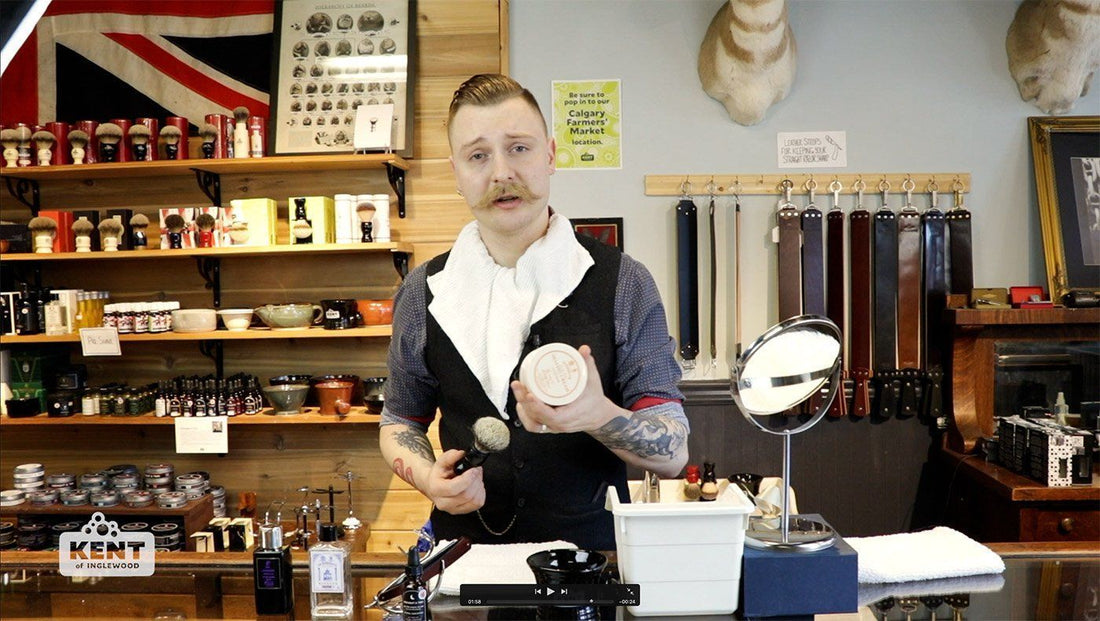
How to Shave with a Straight Razor Part 1: 3 Steps for Preparation
PART 2: TIPS FOR USING YOUR BLADE / PART 3: AFTERSHAVE & RAZOR CARE
Good preparation can make or break a shave. We’ve all had a morning when we’re late for work and hastily drag a disposable blade across our face. It’s not comfortable and it doesn’t lead to good results.
Straight razor edges are thicker than disposable blades. This gives them incredible power when shaving, but it also makes the act of preparing your face that much more important. Before you get to shaving, there are three main steps to follow.
Prepare your blade
Straight razors are made out of very hard steel, in order to get and maintain a smooth shaving edge. Because they are ground very thin, the edge can flex and warp when it cuts through hair, dulling the blade. In order to keep your blade sharp for as long as possible, a leather strop is used to re-align the edge in between shaves. This means that you only have to sharpen your blade on a stone once or twice a year, rather than once or twice a month.
To use the strop, loop it onto a solid hook mounted into a stud or door frame. Pull the strop tight, and gently lay the razor flat across the leather. The spine of the razor will naturally set your angle. Draw the razor across the length of the strop with minimal pressure, leading with the spine of the razor. When you reach the end of the strop stop your motion, roll the razor gently over the spine, and start the motion again in the opposite direction. Repeat this motion 30-40 times, slowly and gently.
Most good strops come with two sides, one smooth and one rough. Like sandpaper, start on the rough side and finish with the smooth side. If you want to get more in-depth knowledge about stropping your razor, check out our How to Strop Your Razor blog and video.
Prepare your shaving brush
A good shaving brush works wonders for the quality of your shave, but it’s important to use and care for it properly. I start by warming my shaving mug or scuttle with hot water, then I refresh the hot water and soak my brush bristles-down for a few minutes. This loads them with water to improve the quality of your lather, but it also prevents damage to your brush. By softening the bristles, you prevent them from breaking down and snapping easily, extending the brush’s lifespan.
Prepare your face
Finally, prepping your face is super important, and a few quick steps will make a world of difference. First, have a hot shower and/or heat your face with hot, damp towels. Do both if possible. The heat and moisture will soften your face and hair, making the hair easier to shave and the skin less likely to get nicked. Once your face is warm, massage in a light coat of pre-shave oil or gel. While this step is optional, it goes a long way for those with shaving issues. Pre-shave oil will offer more protection and glide for sensitive skin, while a gel will provide glide and soften especially thick, stubborn whiskers.
Finally, lather up with your brush and a good shaving soap or cream. Whichever product you use, be sure to spend time lathering the product into your skin. This will form a nice fluffy lather, but is also helps to improve the shave. The action of the brush lifts hairs to prevent in-growns, while the lather will further soften your hairs, reducing the pulling effect that some feel with a razor.
If you follow these steps before every shave, you are well on your way to having an ideal shaving experience. Once you’re ready to use a straight razor razor, check out our tips here.





